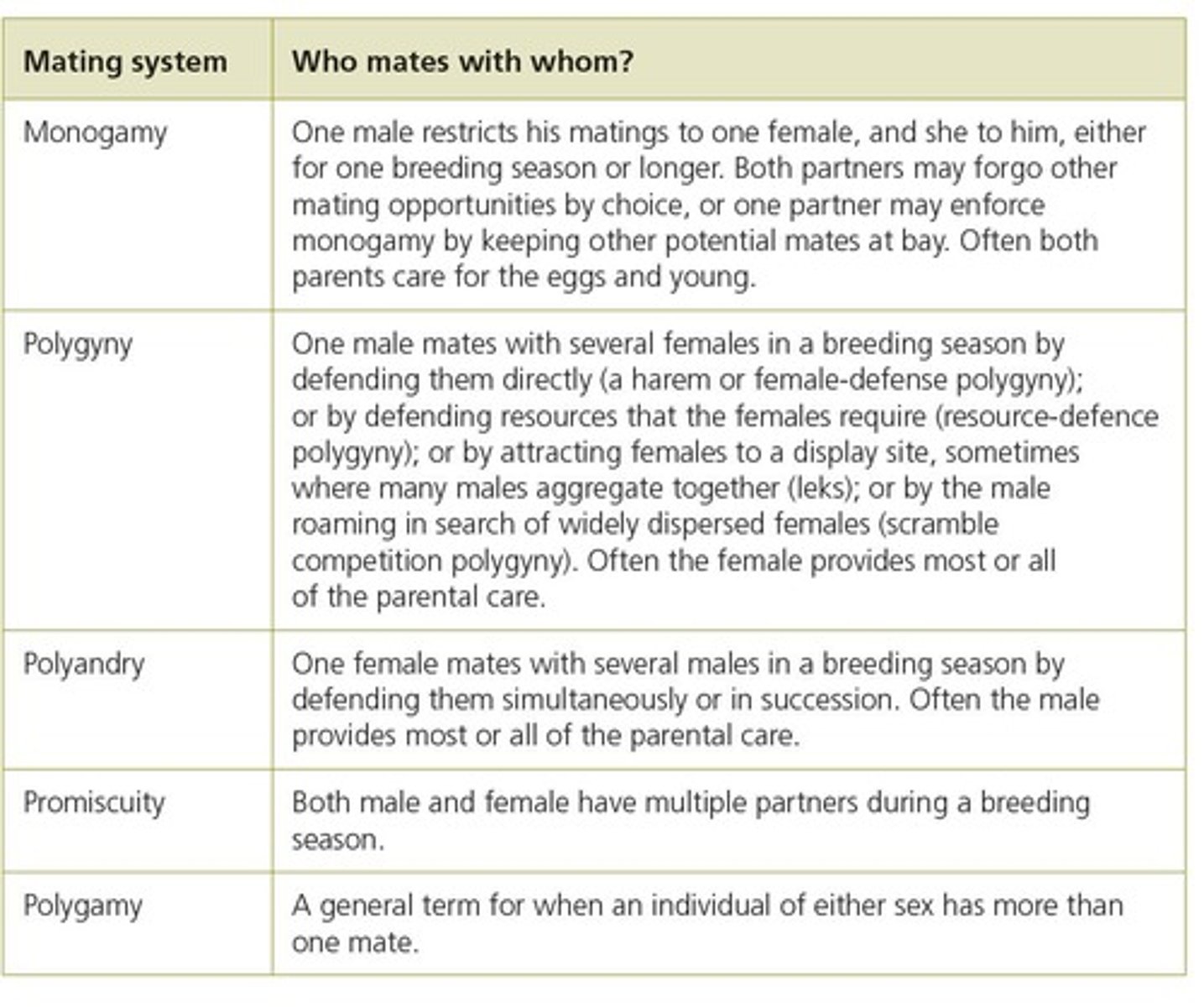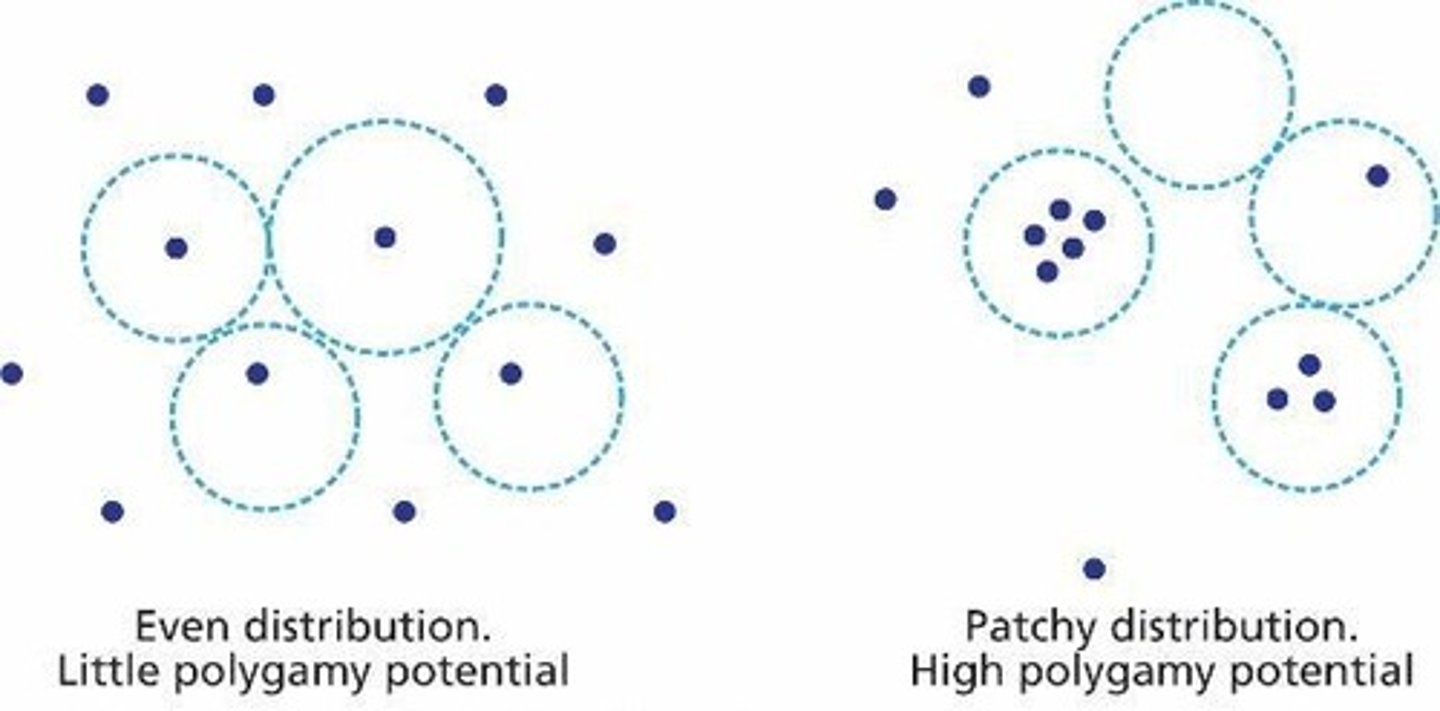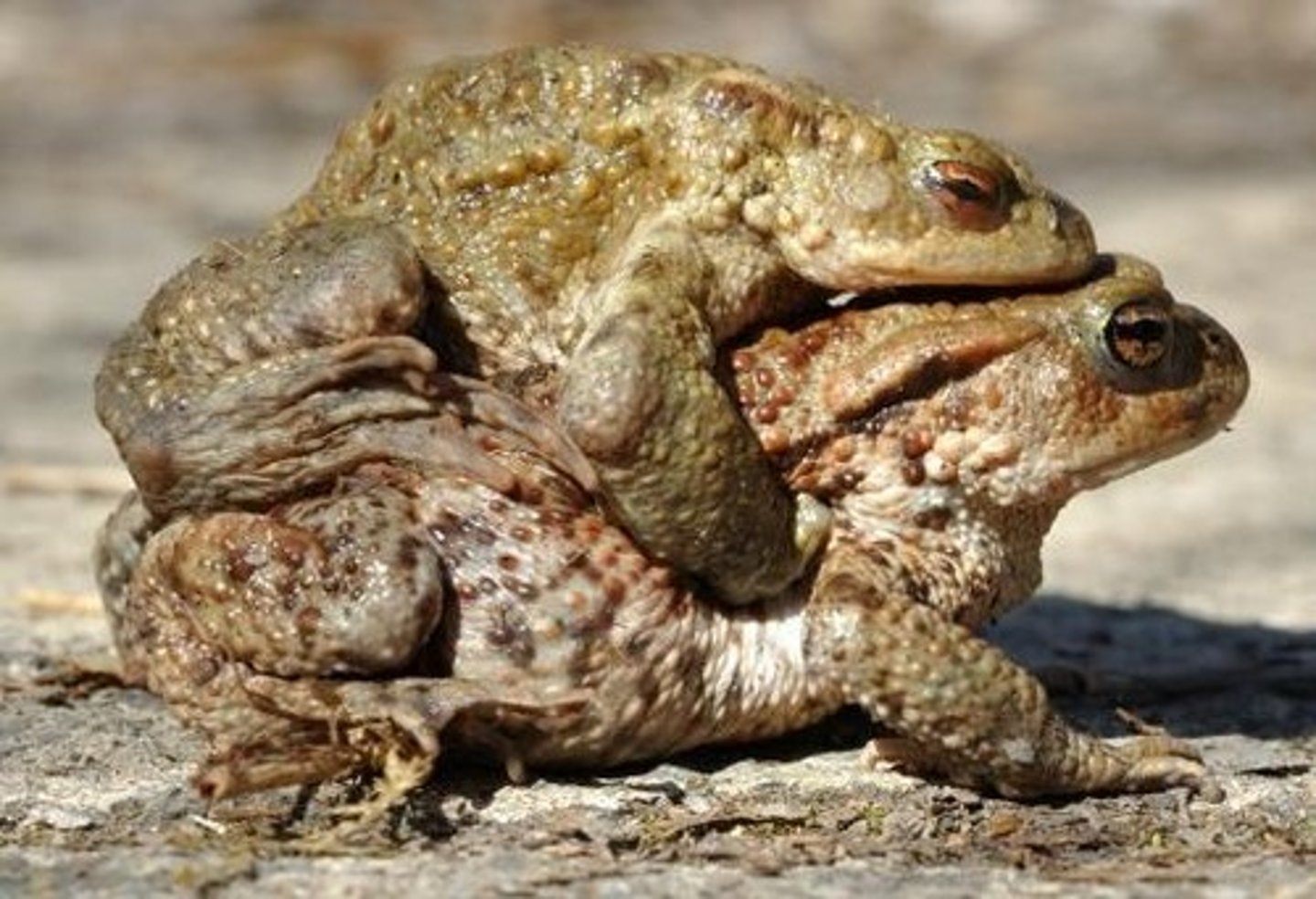Mating Systems and Parental Care in Animal Behavior
1/581
There's no tags or description
Looks like no tags are added yet.
Name | Mastery | Learn | Test | Matching | Spaced |
|---|
No study sessions yet.
582 Terms
What factors determine mating systems?
1. Dispersion in space 2. Patterns of desertion by either sex.
What is a mating system?
A mating system refers to how mates are acquired, how many mates an individual will have, and patterns of parental care.

What are the two main scenarios addressed in mating systems?
1. Mating systems without parental care 2. Mating systems with male parental care.
What limits female reproductive success in mating systems without male parental care?
Female reproductive success is mostly limited by access to resources.
How does female distribution relate to resource dispersion in mating systems without male parental care?
Female distribution depends primarily on resource dispersion, modified by costs and benefits of association with others.
What limits male reproductive success in mating systems without male parental care?
Male reproductive success is limited more by access to females.
How should males distribute themselves in relation to females in mating systems without male parental care?
Males should distribute themselves in relation to female dispersion and can compete directly for females or indirectly through competition for limiting resources.
What are the four major types of mating systems?
The notes do not specify the four major types, but they are generally understood to include monogamy, polygyny, polyandry, and promiscuity.

What role does male parental care play in mating systems?
Mating systems can be categorized based on whether males provide parental care or not.
What is the significance of Nick Davies' work in the context of mating systems?
Nick Davies' work provides an example of all types of mating systems within a single species or population.
What is the relationship between male and female dispersion in space and time?
It determines how easy it is for either sex to gain access to mates.
What is the impact of predation risk on female distribution in mating systems?
Predation risk can modify female distribution based on the costs and benefits of association with others.
What is the two-step process of mating system evolution when males do not provide parental care?
1. Female reproductive success is limited by access to resources. 2. Male reproductive success is limited by access to females.
What are the costs and benefits of parental care in mating systems?
They influence patterns of desertion by either sex.
What is the impact of resource competition on female distribution?
Resource competition can modify female distribution based on the availability of resources.
What does 'desertion by either sex' refer to in mating systems?
It refers to the patterns of leaving or abandoning mates, which can affect reproductive success.
What is the importance of understanding mating systems in biology?
Understanding mating systems helps explain reproductive strategies and behaviors in different species.
How does male competition influence mating systems?
Males can compete directly for females or indirectly through competition for limiting resources.
What is the relationship between female reproductive success and resource access?
Female reproductive success is primarily limited by her access to resources.
What is the significance of social versus solitary females in mating systems?
Their defensibility can influence the mating system and male distribution.
What limits male reproductive success?
Access to females.
How should males distribute themselves in relation to females?
Males should distribute themselves according to female dispersion.
What are two ways males can compete for females?
Males can compete directly for females or indirectly through competition for limiting resources.
What is the likely mating system if resource patches are evenly and broadly distributed?
Monogamy is likely.

Why is monogamy likely in evenly distributed resource patches?
It is hard to defend either resources or multiple females.
What is the likely mating system if resource patches are patchily distributed?
Polygamy is likely.
Why is polygamy likely in patchily distributed resource patches?
It is easier to defend either resources, females, or both.
What factors influence the operational sex ratio (OSR) and breeding synchrony?
If OSR = 1:1 and breeding is synchronous, there is little scope for polygamy. If OSR >> 1:1 (female biased) or breeding is asynchronous, males have more scope for polygamy.
What happens to male mating opportunities in a 1:1 OSR with synchronous breeding?
Males have little scope for polygamy because females will breed before males can mate multiple times.
How does a female-biased OSR affect male mating opportunities?
It increases the scope for males to engage in polygamy.
What is an example of a species with synchronous breeding and a 1:1 OSR?
Common toad (Bufo bufo), where all females breed over a few days.
What is an example of a species with prolonged breeding and a female-biased OSR?
American bullfrog (Lithobates catesbeiana), where females arrive over many weeks.

What drives female dispersion according to experimental evidence from grey-sided voles?
Food availability drives female dispersion.
What did Rolf Anker Ims' experiment with voles demonstrate about male dispersion?
Female dispersion drives male dispersion; males aggregate where females are clumped.
What happens to male distribution when females are spaced out in Ims' experiment?
Males become dispersed.
What happens to male distribution when females are clumped in Ims' experiment?
Males aggregate onto the clumps.
What was the effect of distributing males in cages on female dispersion in Ims' experiment?
There was no effect on female dispersion.
What conclusion can be drawn from Ims' study about the relationship between male and female dispersion?
Female dispersion influences male dispersion.
What was the main hypothesis tested in Rolf Anker Ims' study on voles?
Female dispersion drives male dispersion.
How were the female voles distributed in the study?
Females were placed in cages and moved daily to simulate home range movement.
What effect did female spacing have on male voles?
When females were spaced out, males became dispersed; when females were clumped, males aggregated onto the clumps.
What was the effect of distributing males in cages on female dispersion?
Males distributed in cages had no effect on female dispersion.
What factor was found to drive female dispersion in grey-sided voles?
Food availability.
What happened to female ranges when food was provided in abundance?
Female ranges became smaller and overlapped with other females.
What question arises regarding male voles' behavior in relation to food and females?
Whether males home in on food sites or on the females themselves.
What experiment was conducted on the small Norwegian island regarding moles?
Females were distributed in cages and moved daily to simulate home range movement, leading to observations on male dispersion.
What effect does female dispersion have on male dispersion in moles?
Female dispersion drives male dispersion.
According to Clutton-Brock (1989), what are the three main factors influencing the economics of female monopolization?
1) Female group size, 2) Female home range size, 3) Seasonality of breeding.
What is the relationship between female range size and male mating strategies in solitary female mammals?
If female ranges are small, males can defend multiple females (polygyny); if large, males can only defend one female (monogamy).
Give an example of a monogamous mammal.
Loris.
What percentage of solitary female mammals have males defending one or more females?
60%.
In what percentage of solitary female mammals is there no male paternal care?
97%.
What is the typical litter size trend between monogamous and polygynous species?
Monogamous species tend to have larger litter sizes than polygynous species.
What are the litter size characteristics of felids, canids, and marmosets?
Felids have small litters and are often polygynous; canids have large litters and are monogamous; marmosets are monogamous with male parental care.

What happens to marmoset offspring if the male dies?
The female abandons the offspring as she cannot raise them alone.
What occurs when solitary female mammals wander widely?
Males rove over wide ranges and associate with females during estrous.
How do social female mammals behave in terms of male defense?
If females band in small groups, a single male may defend them as a permanent harem; if in large groups, several males (often kin) defend territory together.
What happens when a new male takes over a harem?
He typically kills the young.
What is the behavior of males in social female species when females are in large groups?
Males may try to defend a harem.
What is the significance of predictable daily movement in female mammals?
If females use a regular route to a specific resource, that area can be defended by males.
What is an example of a species where males defend a territory due to predictable female movement?
Topi and Grevy's zebra.
What are leks and choruses in mating systems?
Males aggregate into groups to defend small territories and advertise for females, with females visiting multiple males before mating.
What is the mating success trend in leks?
Mating success is skewed, with some males achieving the majority of matings.
How common are leks in mammals compared to birds?
Leks are not common in mammals (only 7 species) but are more common in birds (35 species).
What is an example of a lekking mammal?
Walrus or hammer-headed bat.
What is a notable behavior of males in dance flies during mating?
Males come to the lek with prey, allowing females to eat while mating.
How do red harvester ants attract females?
Males congregate and give off pheromones that attract females.
What is the significance of choruses and leks in anurans and insects?
They are extremely common in frogs/toads and occur in several insect species.
What is the purpose of lekking behavior?
To increase mating opportunities through aggregation and display.
What experiment did Rolf Anker Ims conduct on moles?
He introduced moles to a small Norwegian island, distributed females in cages, and moved the cages daily to simulate home range movement.
What was the effect of female spacing on male dispersion in Ims' study?
When females were spaced out, males became dispersed; when females were clumped, males aggregated onto the clumps.
What does Ims' study suggest about the relationship between female and male dispersion?
It suggests that female dispersion drives male dispersion.
What factor drives female dispersion in grey-sided voles according to Ims' findings?
Food drives female dispersion, as providing food in abundance leads to smaller overlapping ranges among females.
What are the three main factors influencing the economics of female monopolization according to Clutton-Brock (1989)?
1) Female group size, 2) Female home range size, 3) Seasonality of breeding.
How does female home range size affect male mating strategies?
If female ranges are small, a male can defend multiple females leading to polygyny; if large, he can only defend one leading to monogamy.
What is an example of a monogamous mammal?
Loris.
What is the typical paternal care behavior in solitary female mammals?
No male paternal care is observed in 97% of solitary female species.
What happens when a new male takes over a harem in social female mammals?
The new male typically kills the young.
What is the behavior of solitary female mammals that wander widely?
Males rove over wide ranges and associate with females when they are in estrous.
What is the behavior of males when females band in small groups?
A single male may defend them as a permanent harem.
What occurs when females band in large groups?
Several males, often kin, defend the territory together.
What is the mating strategy of species like topi and Grevy's zebra?
Males attempt to mate with visiting females at specific water holes or food sources when direct defense is too costly.
What is the significance of leks in mating systems?
Males aggregate into groups to defend small territories and advertise for females, with mating success often skewed.
How common are leks in mammals compared to birds?
Leks are not common in mammals (only 7 species) but are found in 35 species of birds.
What is an example of a lekking bird?
Sage grouse.
What is a unique behavior observed in dance flies during mating?
Males bring prey to the lek, allowing females to eat while mating.
What do red harvester ants do to attract females?
Males congregate and release pheromones to attract females.
What is the role of males in choruses and leks among anurans and insects?
Males attract other males before displaying for females.
What are the five main hypotheses for why leks occur?
The notes did not provide the five hypotheses.
What is the relationship between litter sizes and mating systems?
Monogamous species tend to have larger litter sizes than polygynous species.
What is the typical litter size in felids and canids?
Felids have small litters and are often polygynous, while canids have larger litters and are monogamous.
What happens if a male marmoset dies?
The female abandons the offspring as she cannot raise them herself.
What is the effect of food scarcity on male-male combat in social females?
When food is scarce, direct defense of females is too costly, leading to males associating with females in estrous instead.
What experiment was conducted on moles in a small Norwegian island?
Moles were introduced, and females were distributed in cages that were moved daily to simulate home range movement.
How does female dispersion affect male dispersion in moles?
Female dispersion drives male dispersion; when females are spaced out, males become dispersed, and when females are clumped, males aggregate onto the clumps.
What is the relationship between female range size and male mating strategies?
If female ranges are small, a male can defend multiple females leading to polygyny; if large, he can only defend one leading to monogamy.
What is the paternal care situation in solitary female mammals?
No male paternal care is observed in 97% of these species.
What is the typical litter size comparison between monogamous and polygynous species?
Monogamous species tend to have larger litter sizes than polygynous species.
What are the litter size characteristics of felids and canids?
Felids have small litters and are often polygynous, while canids have larger litters and are monogamous.
What is unique about marmosets in terms of mating and parental care?
Marmosets are monogamous and exhibit male parental care; if the male dies, the female abandons the offspring.